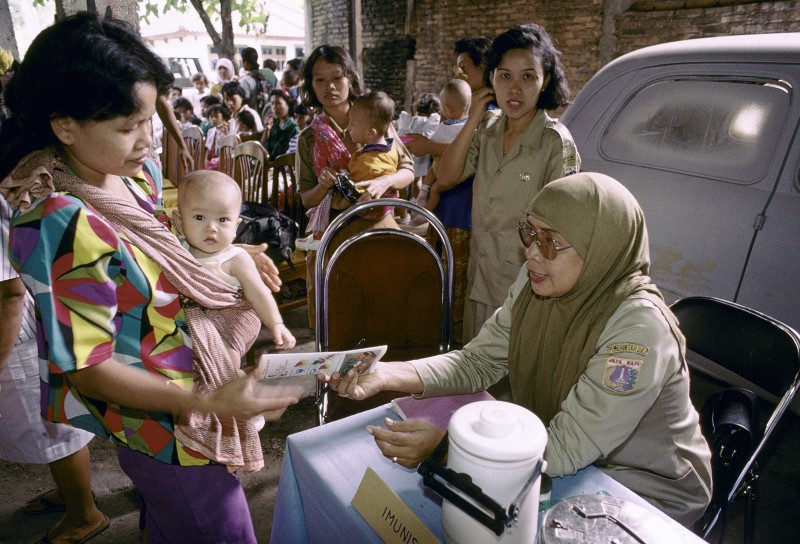Patient reminders increased immunization rates by 8% compared to those not receiving reminders.


Photos by: Curt Carnemark (L), Amira Al-Sharif (M),
![]()
![]()
![]()
Why are patient reminders important?
- Vaccine preventable diseases cause considerable morbidity and mortality worldwide largely due to lower than recommended vaccination rates. A strategy to help ensure immunizations are kept up-to-date is patient reminder and recall systems which were recommended by the Task Force on Community Preventive Services and the Standards for Immunization Practices.
Do patient reminders improve vaccination rates?
- Patient reminders increased immunization rates by 8% compared to those not receiving reminders. Children whose parents received reminders for the influenza vaccine and adults who received reminders for vaccines like tetanus and pneumococcal were more than twice as likely to get vaccinated as those who did not receive a reminder.
Equity: Do they work in the disadvantaged?
Immunization levels tend to be lower in some disadvantaged groups, for example, among lower socioeconomic groups and certain racial or ethnic groups. Therefore patient reminders and recall interventions can improve immunization rates within these groups.
Intervention Delivery
There were five basic types of patient reminder and recall interventions. These included: letters or postcards to patients, person-to-person telephone calls, computerized phone messages, post card and phone combination, tracking and outreach, and reminders for providers along with patients.
Population and Setting
All 75 included studies were conducted in diverse countries, including a mix of urban and rural settings: Australia, Canada, Denmark, Kenya, New Zealand, Nigeria, Spain, United Kingdom, United States, and Zimbabwe.
- Participants included children receiving reminders about routine vaccinations, influenza vaccine reminders for high risk children and infants, high risk adults receiving influenza vaccine reminders, adults receiving reminders about tetanus, pneumococcal, or hepatitis B vaccine, and adolescents receiving reminders.
Summary of Findings [SOF] Table: Patient reminders versus control to improve immunization rates
Patient or population: Infants, children, and adults
Settings: private practice/public health department/academic medical center/clinical settings
Intervention: Patient reminders
Comparison: No reminders, standard practice
| Outcomes | Anticipated absolute effects | Relative effect | No of Participants | Quality of the evidence | ||
| Without patient reminders | With patient reminders (95% CI) | |||||
| Immunized (influenza-child) | 431 per 1000 | 220 more per 1000 (from 60-426 more) | RR 1.51 (1.14-1.99) | 9256 (5) | Moderate1 | |
| Immunized (preschool child) | 333 per 1000 | 73 more per 1000 (from 5.5 to 12.1 more) | RR 1.22 (1.15-1.29) | 31,099 (23) | High | |
| Immunized (influenza-adult) | 292 per 1000 | 84 more per 1000 (from 10 fewer to 412 more) | RR 1.29 (1.17-1.43) | 59,328 (15) | Moderate2 | |
| Immunized (other adult) | 109 per 1000 | 118 more per 1000 (from 7.0 to 60.2 more) | RR 2.08 (0.91-4.78) | 8065 (4) | Moderate3 | |
| Immunized (adolescent) | 244 per 1000 | 70 more per 1000 (from 41-102 more) | RR 1.29 (1.17-1.42) | 30,868 (10) | High | |
| Adverse Events: None reported | ||||||
| About quality of evidence (GRADE) | ||||||
1. Downgraded by 1.5 due to imprecision and inconsistency. One of 5 studies had a wide confidence interval.
2. Downgraded by 2 due to lack of agreement between studies and imprecision. Effect sizes ranged from 1.08-3.61 and two of 5 studies had wide confidence intervals.
3. Downgraded by 1.5 due to imprecision and inconsistency. Effect sizes ranged from 0.91-3.11 and one study had a wide confidence interval.
| Relevance of the review for disadvantaged communities | |
| Findings | Interpretation |
| Equity – Which of the PROGRESS groups examined |
|
| All included studies were conducted in countries of varying income status and included a variety of participants in multiple settings (private practices, academic medical centres, and public health departments). | The results may not be applicable in low- and middle-income countries. |
| One study included healthy and high-risk receiving patient reminders for influenza vaccines. | The combined data shows that participants receiving reminders about influenza vaccines were more than twice as likely to receive the vaccine. Reminders were effective for high risk and healthy children. |
| Equity Applicability |
|
| Most included studies were conducted in high-income countries with almost half conducted in the United States. | The applicability of the evidence to low- and middle-income countries is unknown and would not be applicable for settings that use vaccination days to provide immunizations. |
| The most effective intervention was patient reminder and recall interventions in combination with provider reminder. | These results are applicable in settings in which the patient has a regular immunization provider who can follow up when additional vaccines are needed. However, general reminders for providers that include the recommended vaccination schedule and frequency of booster shots may help all patients receive the recommended vaccines. |
| Person-to-person telephone reminders were the second most effective intervention type followed by letters, postcards, computerized phone messages, postcards with phone calls, and reminder and recall with outreach. | Policymakers implementing a patient reminder intervention need to consider the following characteristics to determine the best type of reminder system for their local settings: - Current computer systems and availability of programmers - Staff - Accuracy of patient phone numbers or addresses - Estimated patient responsiveness - Costs associated with telephone calls and mailed postcards/letters - Known vaccination status of population of interest These interventions may not be feasible in all low-income settings. Mobile phone reminders are a better option than landlines and may be effective in low- or middle-income countries. Policymakers implementing an immunization reminder intervention will need to consider which options are the best for their local setting. |
| Cost-equity |
|
| The review does not provide information on the cost-effectiveness of patient reminders for immunization. | The cost-effectiveness of patient reminders for immunizations is unknown. However, since disadvantaged populations are more likely to have lower immunization rates patient reminders could increase immunization rates for disadvantaged children and lower the burden of vaccine preventable diseases. |
| Monitoring & Evaluation for PROGRESS Groups |
|
| Patient reminders can improve vaccination rates for children and adults. | All immunization reminder interventions need to have a monitoring and evaluation plan to ensure that those most in need of patient reminders are receiving them and getting the necessary vaccinations. |
Comments on this summary? Please contact Jennifer Petkovic.
Drafted by Chaeyon Lee
